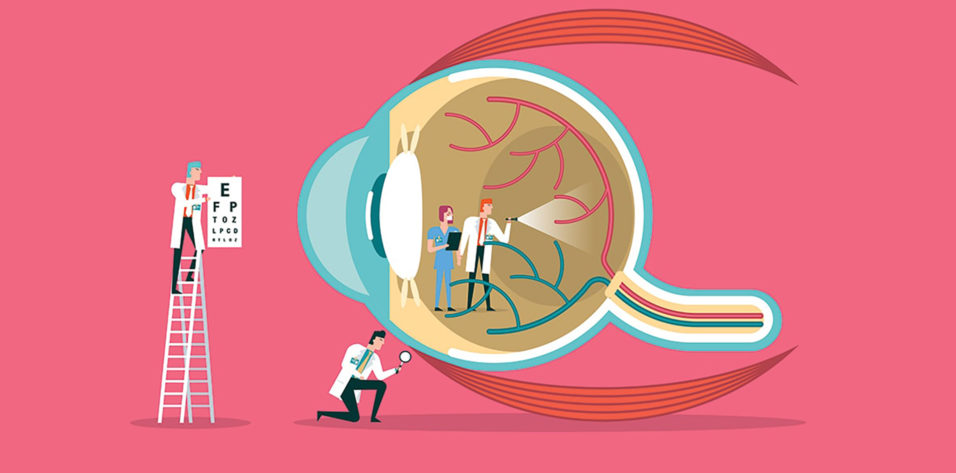

The COVID-19 pandemic has the potential to severely affect visual outcomes for people with age-related macular degeneration (AMD). Vestrum Health, an electronic health record data analytics provider in the retina space, recently published data illustrating a massive gap in care that the pandemic has created for these individuals. The data show a 67% drop in new dry AMD patient visits from March to May 2020 compared with the same period last year.1
AT A GLANCE
- The early detection of wet age-related macular degeneration (AMD) is crucial to maintaining patients’ functional vision and quality of life.
- The standard method for detecting conversion from dry to wet AMD, the Amsler grid, is subject to compliance problems and other issues.
- A remote system for monitoring patients with intermediate dry AMD that can overcome some of these problems may be especially valuable during and after the current pandemic.
What is particularly troubling in this finding is that some of those missing patients may have converted to wet AMD without detection and are consequently not being treated. The data imply that the lockdowns that have taken place in response to the pandemic may result in a significant number of people with AMD going undiagnosed and untreated, potentially leading to permanent irreparable vision loss for many.
This scenario is less than ideal for therapy outcomes. As primary eye care physicians, optometrists can play a critical role in collaboration with ophthalmologists, not only in detecting wet AMD early, but in ensuring the best visual outcomes for patients.
IMPORTANCE OF EARLY DETECTION
The early detection of wet AMD is crucial to maintaining patients’ functional vision and quality of life. Many studies have demonstrated that the better a patient’s visual acuity is at the time of anti-VEGF treatment initiation, the higher the likelihood that long-term visual acuity will be better.2,3 However, real-world data show that patients present with an average of 20/83 VA at wet AMD diagnosis using current standard of care.4 Although anti-VEGF treatment has revolutionized vision outcomes for patients with wet AMD, it must be initiated at the earliest signs of conversion to help patients maintain their vision.
REMOTE PATIENT MONITORING
We think the time has come for individuals with dry AMD, who are more at risk of converting to wet AMD than individuals with no AMD, to have access to advanced home-based remote diagnostics that allow physicians to remotely monitor their disease, with the aim of detecting conversion earlier.
Currently, many optometrists’ standard of care protocol for dry AMD is Amsler grid testing. However, by the time wet AMD is detected using the Amsler grid, vision loss for many patients is irreversible or vision is so poor that a good outcome is not likely. Several studies have found that only 9% to 41% of newly diagnosed patients with wet AMD are detected early with good functional vision (20/40 or better),5-7 and that testing with the Amsler grid alone is not effective.4
Wet AMD may be present for 6 to 12 months before detection and treatment. That is, when a patient notes distortion on the Amsler grid, vision loss may have already progressed.2 Most physicians rely on their patients to notice and report these distortions, but compliance is often poor and difficult to verify. And even with the best of efforts, using an Amsler grid is fraught with difficulties.
BEYOND AMSLER
Today, advanced technology is available that overcomes many of the limitations of the Amsler grid. The ForeseeHome AMD Monitoring Program (Notal Vision) is an advanced home-based monitoring program for use by patients with intermediate dry AMD that helps detect conversion to wet AMD earlier than traditional methods.
The AREDS2-HOME study, sponsored by the National Eye Institute, found that 94% of patients using ForeseeHome who progressed to wet AMD retained functional vision, versus 62% of patients using standard detection methods such as the Amsler grid in the control arm.8 The independent data safety and monitoring committee for the study stopped the trial early due to the efficacy of the ForeseeHome system; patients using the device had significantly fewer letters of vision loss at wet AMD conversion compared to those receiving standard care only.
A recent retrospective analysis reviewed medical records from the Notal Vision Diagnostic Clinic, an independent diagnostic testing facility and medical service provider of ForeseeHome. The investigators identified 306 eyes that converted to wet AMD between October 2009 and September 2018.9 Of those conversions, the ForeseeHome system identified 69%, confirming the findings of the AREDS2 randomized controlled HOME study, in which 64% of detections were triggered by ForeseeHome alerts in a comparable group.10 Functional vision at conversion was maintained in 83% of patients in the real-world ForeseeHome cohort compared with 34% receiving standard of care in the American Academy of Ophthalmology’s IRIS Registry.11
ForeseeHome uses preferential hyperacuity perimetry to detect tiny changes in the user’s central visual field, including metamorphopsia and scotomas. Patients are instructed to test their prescribed eye or eyes daily, and their responses are automatically transmitted to the Notal Vision Diagnostic Clinic at the end of each test. The wireless communication technology used by the system facilitates fast, reliable transmission of data, and the results are then made available to the physician through a secure online portal.
Tests are continually compared to the patient’s own baseline. When a statistically significant change of test patterns is detected, the remote diagnostic clinic alerts the physician so he or she can schedule a prompt examination with the patient. Physicians who refer patients to the Notal Vision Diagnostic Clinic can rely on the patient engagement, education, device setup, support, and compliance monitoring the clinic provides over the phone and via email. In addition, the ForeseeHome system is cleared by the FDA and its use is covered by Medicare Plan B (80/20). Many patients pay little out-of-pocket cost.
REMOTE MONITORING FOR THE WIN
The COVID-19 pandemic made the value of remote patient monitoring clear to many in the field of health care. A remote monitoring program such as the ForeseeHome AMD Monitoring Program can be valuable to optometrists not only during this pandemic but beyond it, facilitating the comanagement of patients with AMD with their ophthalmologist colleagues.
Advanced remote monitoring can not only lead to better visual outcomes, but it can also help to strengthen optometric practices by providing a superior level of care for patients with AMD. Optometrists can solidify their long-term relationships with their patients and refer for specialty care only when treatment is needed. As many medically minded optometrists seek to differentiate their practices, advanced remote monitoring for patients with intermediate dry AMD is a step in the right direction.
1. Williams DF. Tracking the impact of COVID-19 on the retina community. Retina Times. July 2020.
2. Ho AC, Albini TA, Brown DM, Boyer DS, Regillo CD, Heier JS. The potential importance of detection of neovascular age-related macular degeneration when visual acuity is relatively good. JAMA Ophthalmol. 2017;135(3):268-273.
3. Comparison of Age-related Macular Degeneration Treatments Trials (CATT) Research Group, Maguire MG, Martin DF, et al. Five-year outcomes with anti-vascular endothelial growth factor treatment of neovascular age-related macular degeneration: The Comparison of Age-Related Macular Degeneration Treatments Trials. Ophthalmology. 2016;123(8):1751-1761.
4. Rao P, Lum F, Wood K, et al. Real-world vision in age-related macular degeneration patients treated with single anti-VEGF drug type for 1 year in the IRIS Registry. Ophthalmology. 2018;125(4):522-528.
5. IVAN Study Investigators, Chakravarthy U, Harding SP, et al. Ranibizumab versus bevacizumab to treat neovascular age-related macular degeneration: one-year findings from the IVAN randomized trial [published correction appears in Ophthalmology. 2012;119(8):1508] [published correction appears in Ophthalmology. 2013 Sep;120(9):1719]. Ophthalmology. 2012;119(7):1399-1411.
6. Data on file. Notal Vision, 2017.
7. Loewenstein A, Malach R, Goldstein M, et al. Replacing the Amsler grid: a new method for monitoring patients with age-related macular degeneration. Ophthalmology. 2003;110(5):966-970.
8. AREDS2-HOME Study Research Group, Chew EY, Clemons TE, et al. Randomized trial of a home monitoring system for early detection of choroidal neovascularization home monitoring of the eye (HOME) study. Ophthalmology. 2014;121(2):535-544.
9. Ho AC. Real-world performance of a self-operated home monitoring system for early detection of choroidal neovascularization in AMD (ForeseeHome Device). Paper presented at: ASRS Virtual Annual Meeting; July 24-26, 2020.
10. Chew EY, Clemons TE, Bressler SB, et al. Randomized trial of the ForeseeHome monitoring device for early detection of neovascular age-related macular degeneration. The Home Monitoring of the Eye (Home) Study Design – Home Study Report Number 1. Contemp Clin Trials. 2014;37:294-300.
11. Ho AC. A retrospective analysis of real-world disease detection and visual acuity outcomes in patients with dry AMD converting to wet AMD using the AAO Iris Registry database. Paper presented at: American Society of Cataract and Refractive Surgery; April 13-17, 2018; Washington, DC.



